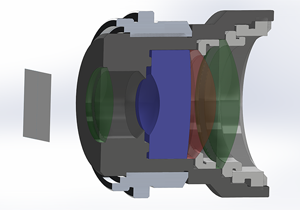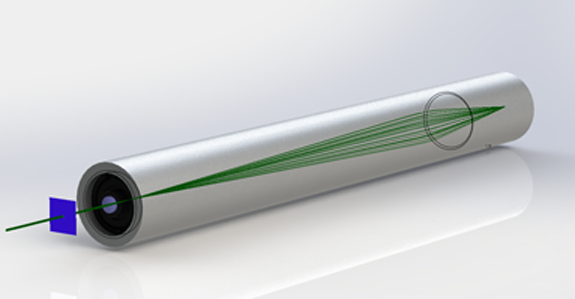Reflections stories feature groundbreaking innovations that showcase the impact of Zemax software on the optics industry. In this issue, Zemax is excited to introduce our newest software for simulation and analysis, LensMechanix™. This powerful software is for mechanical engineers who design optomechanical products, which is the next step after an optical design is completed in OpticStudio™.
We interviewed Andy Ferris, LensMechanix product manager, to find out why Zemax created this product.
Zemax: What was the genesis of the creation of LensMechanix?
Andy: As the leader in optical design software, Zemax is ideally positioned to solve many of the challenges that are downstream from optical design. About 22 months ago, we began talking to optical engineers, mechanical engineers, and engineering managers to understand their workflow, biggest pain points, and tools they use.
To give you some context, both optical and mechanical engineers play key roles in the optomechanical design process. Optical engineers use simulation software to design optical systems “floating in free space.” They determine the positions and specifications of the lenses, mirrors, prisms, gratings, and other optical components to achieve a given performance goal and meet design specifications.
Mechanical engineers then build the packaging (or housing) for the optical system. As part of this design process, they make decisions about non-optical materials, surface finishes, stresses, vibrations, tolerances, manufacturability, and other factors—while considering how the mechanical components affect the optical performance or functionality of the system. Mechanical engineers must also account for brand consistency, user experience, and industrial design (such as weight, look and feel, and durability). In this vital role, mechanical engineers make it possible for a lens design to become a functional product.


Zemax: What did you learn from talking to optical and mechanical engineers that helped you identify an opportunity for a product like LensMechanix?
Andy: In conducting interviews and surveys with dozens of optical and mechanical engineers, we learned that the transition between the optical and mechanical design phases is costly, time-consuming, and difficult. Optical and mechanical engineers must work closely to turn an optical system design into reality. Yet disparities in toolsets, software environments, file formats, and performance metrics make the workflow inefficient and arduous. We heard that in some organizations, optical engineers have to throw designs over the wall to mechanical engineers, and vice versa, with no real collaboration. Design and production teams have struggled with this process for decades.
In conducting interviews and surveys with dozens of optical and mechanical engineers, we learned that the transition between the optical and mechanical design phases is costly, time-consuming, and difficult.
We identified several pain points that optical and mechanical engineers face:
Collaboration using different file formats is difficult. Optical and mechanical engineers work in different design environments, which requires them to import and export files and perform file conversions to make the files compatible with their respective design software. With each file export and import, time is wasted and design fidelity is lost.
The file formats approximate the optical geometry. Typically, an optical engineer sends a standardized graphic exchange (STEP) file, initial graphics exchange specification (IGES) file, or stereo lithography (STL) file to a mechanical engineer. These files are "data blobs" that lack optical design or component data. As visual approximations of the optical and ray geometry, the files are an imprecise way to communicate design intent and prone to introducing errors and inconsistencies. They are also laborous to work with. Without actual lens data and tools to analyze the optomechanical design, mechanical engineers are flying blind. With the precision that most lens designs require, "close" is rarely close enough.
Mechanical engineers must manually rebuild the optical system in their CAD program. For a complex system such as a telescope or high-power laser with many lenses, manually rebuilding the optical system can take days, weeks, or longer, it also the likelihood of introducing errors. Mechanical engineers must rely on rules of thumb or guesswork as they build mechanical components around the lens system while trying to preserve the integrity of the optical design and performance.
Mechanical engineers lack an effective way to identify optomechanical problems. They have no way to analyze their own designs to determine how mechanical components might affect the optical system. To validate the design, they either re-export the file to the optical engineer to validate, or they use a "build and break" model by manufacturing a physical prototype to assess the product’s performance. Either way, the design is often returned to the optical or mechanical engineer requiring changes. They may repeat this trial-and-error process numerous times before the mechanical design is compatible with the optical system, wasting weeks of development time and costing lots of resources.
LensMechanix makes my life easier. I used to have to create the parts from scratch. Now that I have actual lens data, my optical engineer doesn’t have to generate tables and I don’t have to generate part files.
-Harold Brunt
Mechanical components can degrade optical performance in many ways. It turns out that even subtle changes to the mechanical geometry can have a major impact on optical performance. Two common problems are stray light and vignetting due to beam clipping. Stray light can be introduced into an optical system in many ways during the design process. Without the same tools and capabilities that the optical designer used, mechanical engineers have no quick or accurate way to tell if the mechanical design is introducing stray light or beam clipping.
As an example, a 45-degree chamfer (or bevel) front edge can introduce stray light into the optical system. By building a 90-degree step or series of small steps instead, a mechanical engineer can reduce the stray light or eliminate it altogether.
 Figure 2. This 45° angle of the chamfer introduces stray light.
Figure 2. This 45° angle of the chamfer introduces stray light. Figure 3. The stray light is corrected by changing the camfer angle to a step.
Figure 3. The stray light is corrected by changing the camfer angle to a step.
As an industry leader over the last 25 years, we felt confident that Zemax could tackle these pain points and challenges that have made the handoff between optical engineers and mechanical engineers time-consuming, costly, prone to error, and frustrating. We sought to build a solution that would streamline workflow and communication, transfer real data, simplify and speed up the design process, and enable optical and mechanical engineers to work in their preferred environments.
If I had had LensMechanix in my last job, it would have saved us two months and prevented us from negatively affecting the entire schedule, from engineering to sales and marketing.
-Dave Rook
Zemax: How does LensMechanix simplify the workflow and communication between optical and mechanical engineers?
Andy: LensMechanix loads an OpticStudio design from a .zmx file with all of the optical information directly into a SOLIDWORKS assembly, eliminating the need for STEP, IGS, and STL files. From there, mechanical engineers can design the mechanical geometry using actual lens dimensions (they don’t need OpticStudio itself). They can then run ray traces using Zemax’s powerful physics core engine to assess the impact of the mechanical design on optical performance.
Mechanical engineers can identify and eliminate problems due to the mechanical geometry before they build a physical prototype or send the design back to optical engineers as an OpticStudio output file for review. Collaborating on a common design dramatically reduces the number of development iterations and helps reduce or even eliminate design errors or manufacturing mistakes.
Mechanical engineers can identify and eliminate problems due to the mechanical geometry before they build a physical prototype or send the design back to optical engineers as an OpticStudio output file for review.
By creating an accurate virtual prototype of the complete optomechanical design, mechanical engineers avoid the costly cycle of creating physical prototypes and redesigning that is so common today.
 Figure 4. A ray trace runs through an optomechanical design in LensMechanix. With LensMechanix,
mechanical engineers can now leverage the power of Zemax’s ray tracing engine while working in the
familiar SOLIDWORKS environment.
Figure 4. A ray trace runs through an optomechanical design in LensMechanix. With LensMechanix,
mechanical engineers can now leverage the power of Zemax’s ray tracing engine while working in the
familiar SOLIDWORKS environment.
Zemax: What has been the public’s reaction to LensMechanix so far?
Andy: When we first introduced LensMechanix at SOLIDWORKS World and Photonics West in early 2016, people saw what we were offering, and the lightbulb came on. They realized that there was a much better way to package and analyze their mechanical designs. After gathering a lot of feedback during an early adopter program, we released LensMechanix to the public in May 2016.
When we first introduced LensMechanix at SOLIDWORKS World and Photonics West in early 2016, people saw what we were offering, and the lightbulb came on. They realized that there was a much better way to package and analyze their mechanical designs.
Since May, we’ve seen a rapid uptick in adoption and a lot of enthusiasm from mechanical engineers. Several have told us that LensMechanix has transformed the way they work and dramatically improved their workflow with optical engineers. We continue to add capabilities to the product based on customer feedback. Best of all, customers who bought a single license to test out LensMechanix are now buying seats for all of their mechanical engineers.
 Figure 5. A mechanical engineer used LensMechanix to create this SOLIDWORKS model of a laser system built in OpticStudio. The virtual prototype helped him find and resolve problems caused by the mechanical geometry before he built a physical prototype.
Figure 5. A mechanical engineer used LensMechanix to create this SOLIDWORKS model of a laser system built in OpticStudio. The virtual prototype helped him find and resolve problems caused by the mechanical geometry before he built a physical prototype. To contact Andy Ferris, please email Andy.Ferris@Zemax.com